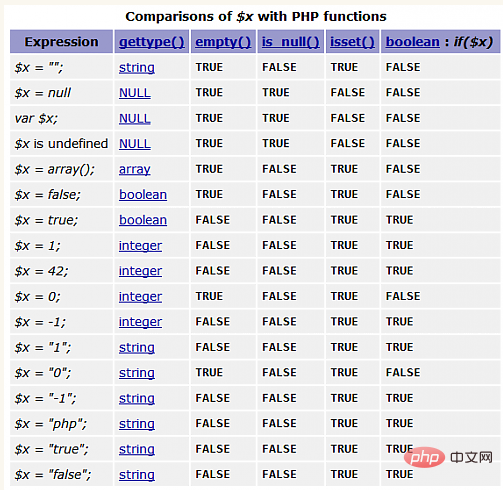PHP判断变量是否为空的方法:可以利用empty()函数来判断。empty()函数用于检查一个变量是否为空,如果变量是非空或非零的值,则该函数返回FALSE。

PHP怎么判断变量是否为空
PHP 判断变量是否为空
关于 empty()
empty() 用于检查一个变量是否为空。如果变量是非空或非零的值,则 empty() 返回 FALSE。换句话说,""、0、"0"、NULL、FALSE、array()、var $var; 以及没有任何属性的对象都将被认为是空的,如果 var 为空,则返回 TRUE。
empty() 与 isset() 的一个简单比较。
<?php
$var = 0; // 结果为 true,因为 $var 为空
// 结果为 true,因为 $var =0
if (empty($var)) { echo '$var is either 0 or not set at all'; }
//结果为false, 因为$var已经设置了
if (!isset($var)) { echo '$var is not set at all'; }
?>由于这是一个语言结构而非函数,因此它无法被变量函数调用。
empty() 只检测变量,检测任何非变量的东西都将导致解析错误。换句话说,后边的语句将不会起作用: empty(addslashes($name))。

empty 判断一个变量是否为“空”,isset 判断一个变量是否已经设置。正是这种所谓的“顾名思义”,令我开始时走了些弯路:当一个变量值等于0时,empty()也会成立(True),因而会发生一些意外。原来,empty 和 isset 虽然都是变量处理函数,它们都用来判断变量是否已经配置,它们却是有一定的区别:empty还会检测变量是否为空、为零。当一个变量值为0,empty 认为这个变量同等于空,即相当于没有设置。
比如检测 $id 变量,当 $id=0 时,用empty 和 isset 来检测变量 $id 是否已经配置,两都将返回不同的值—— empty 认为没有配置,isset 能够取得 $id 的值:
测试代码
<?php
$id = 0;
empty($id) ? print '变量 $id 为空.' : print '$id'.'的值为 '."$id";
print "<br>";
!isset($id) ? print "It's empty .":print '$id'." 的值为 $id .";
?>程序运行结果:
变量 $id 为空. $id 的值为 0 .
这意味着,我们在使用变量处理函数时,当该变量可能出现0的值,使用 empty 要小心,这个时候用 isset 取代它更明智一些。
当一个php页面的 URL 尾部参数出现 id=0 时(比如:test.php?id=0),试比较:
if(empty($id)) $id=1; // 若 id=0 ,id 也会为1 if(!isset($id)) $id=1; // 若 id=0 ,id 不会为1
可分开运行以下代码检测上述推断:
if(empty($id)) $id=1; print $id; // 得到 1 if(!isset($id)) $id=1; print $id; //得到 0
更多相关技术知识,请访问PHP中文网!
 The Continued Use of PHP: Reasons for Its EnduranceApr 19, 2025 am 12:23 AM
The Continued Use of PHP: Reasons for Its EnduranceApr 19, 2025 am 12:23 AMWhat’s still popular is the ease of use, flexibility and a strong ecosystem. 1) Ease of use and simple syntax make it the first choice for beginners. 2) Closely integrated with web development, excellent interaction with HTTP requests and database. 3) The huge ecosystem provides a wealth of tools and libraries. 4) Active community and open source nature adapts them to new needs and technology trends.
 PHP and Python: Exploring Their Similarities and DifferencesApr 19, 2025 am 12:21 AM
PHP and Python: Exploring Their Similarities and DifferencesApr 19, 2025 am 12:21 AMPHP and Python are both high-level programming languages that are widely used in web development, data processing and automation tasks. 1.PHP is often used to build dynamic websites and content management systems, while Python is often used to build web frameworks and data science. 2.PHP uses echo to output content, Python uses print. 3. Both support object-oriented programming, but the syntax and keywords are different. 4. PHP supports weak type conversion, while Python is more stringent. 5. PHP performance optimization includes using OPcache and asynchronous programming, while Python uses cProfile and asynchronous programming.
 PHP and Python: Different Paradigms ExplainedApr 18, 2025 am 12:26 AM
PHP and Python: Different Paradigms ExplainedApr 18, 2025 am 12:26 AMPHP is mainly procedural programming, but also supports object-oriented programming (OOP); Python supports a variety of paradigms, including OOP, functional and procedural programming. PHP is suitable for web development, and Python is suitable for a variety of applications such as data analysis and machine learning.
 PHP and Python: A Deep Dive into Their HistoryApr 18, 2025 am 12:25 AM
PHP and Python: A Deep Dive into Their HistoryApr 18, 2025 am 12:25 AMPHP originated in 1994 and was developed by RasmusLerdorf. It was originally used to track website visitors and gradually evolved into a server-side scripting language and was widely used in web development. Python was developed by Guidovan Rossum in the late 1980s and was first released in 1991. It emphasizes code readability and simplicity, and is suitable for scientific computing, data analysis and other fields.
 Choosing Between PHP and Python: A GuideApr 18, 2025 am 12:24 AM
Choosing Between PHP and Python: A GuideApr 18, 2025 am 12:24 AMPHP is suitable for web development and rapid prototyping, and Python is suitable for data science and machine learning. 1.PHP is used for dynamic web development, with simple syntax and suitable for rapid development. 2. Python has concise syntax, is suitable for multiple fields, and has a strong library ecosystem.
 PHP and Frameworks: Modernizing the LanguageApr 18, 2025 am 12:14 AM
PHP and Frameworks: Modernizing the LanguageApr 18, 2025 am 12:14 AMPHP remains important in the modernization process because it supports a large number of websites and applications and adapts to development needs through frameworks. 1.PHP7 improves performance and introduces new features. 2. Modern frameworks such as Laravel, Symfony and CodeIgniter simplify development and improve code quality. 3. Performance optimization and best practices further improve application efficiency.
 PHP's Impact: Web Development and BeyondApr 18, 2025 am 12:10 AM
PHP's Impact: Web Development and BeyondApr 18, 2025 am 12:10 AMPHPhassignificantlyimpactedwebdevelopmentandextendsbeyondit.1)ItpowersmajorplatformslikeWordPressandexcelsindatabaseinteractions.2)PHP'sadaptabilityallowsittoscaleforlargeapplicationsusingframeworkslikeLaravel.3)Beyondweb,PHPisusedincommand-linescrip
 How does PHP type hinting work, including scalar types, return types, union types, and nullable types?Apr 17, 2025 am 12:25 AM
How does PHP type hinting work, including scalar types, return types, union types, and nullable types?Apr 17, 2025 am 12:25 AMPHP type prompts to improve code quality and readability. 1) Scalar type tips: Since PHP7.0, basic data types are allowed to be specified in function parameters, such as int, float, etc. 2) Return type prompt: Ensure the consistency of the function return value type. 3) Union type prompt: Since PHP8.0, multiple types are allowed to be specified in function parameters or return values. 4) Nullable type prompt: Allows to include null values and handle functions that may return null values.


Hot AI Tools

Undresser.AI Undress
AI-powered app for creating realistic nude photos

AI Clothes Remover
Online AI tool for removing clothes from photos.

Undress AI Tool
Undress images for free

Clothoff.io
AI clothes remover

Video Face Swap
Swap faces in any video effortlessly with our completely free AI face swap tool!

Hot Article

Hot Tools

Notepad++7.3.1
Easy-to-use and free code editor

Dreamweaver Mac version
Visual web development tools

ZendStudio 13.5.1 Mac
Powerful PHP integrated development environment

SAP NetWeaver Server Adapter for Eclipse
Integrate Eclipse with SAP NetWeaver application server.

DVWA
Damn Vulnerable Web App (DVWA) is a PHP/MySQL web application that is very vulnerable. Its main goals are to be an aid for security professionals to test their skills and tools in a legal environment, to help web developers better understand the process of securing web applications, and to help teachers/students teach/learn in a classroom environment Web application security. The goal of DVWA is to practice some of the most common web vulnerabilities through a simple and straightforward interface, with varying degrees of difficulty. Please note that this software





